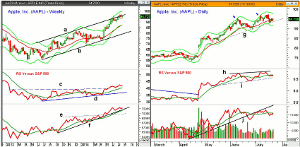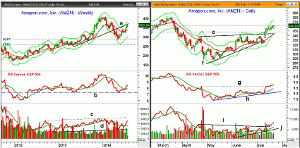The fundamental analysts are still digesting yesterday’s earnings reports from these two tech giants, so MoneyShow’s Tom Aspray analyzes them both to see whether they’re more likely to have a higher or lower weekly close.
The sharply higher opening Tuesday in reaction to earnings from Netflix, Inc. (NFLX) and Chipolte Mexican Grill (CMG) stabilized the market’s short-term outlook. The S&P futures broke out of their recent trading range during the day but failed to breakout on a closing basis. The S&P 500 also made a new intra-day high.
Another strong close should be enough to signal another push to the upside as the market internals were 2-1 positive Tuesday. The NYSE Advance/Decline has moved back above its WMA after dropping to new lows for the month last week.
Most traders yesterday were waiting for the earnings from Apple, Inc. (AAPL) and Microsoft, Inc. (MSFT) after the close. The fundamental analysts are still digesting both earnings reports but—in after hours trading—AAPL was trading a bit lower.
The Citigroup, Inc. (C) downgrade of Amazon.com (AMZN) ahead of Thursday’s earnings also got the market’s attention. The reviews of their new phone also increased the attention before their earnings. In April, Amazon.com (AMZN) was also downgraded after a disappointing earnings report but the stock bottomed out just two weeks later.
The close today in the big tech stocks could help determine whether they will have a higher or lower weekly close. A flat or higher weekly close in many key stocks would be a positive sign and would increase the odds that the major averages will make further new highs.
However, a lower close, especially below last week’s lows could send an important message about the short-term health of the tech sector. Often, “red flags” from the weekly charts can provide reliable warnings of more serious corrections.
Chart Analysis: The weekly chart of Apple, Inc. (AAPL) shows that it is still bumping into the upper boundary of its year long trading channel (line a), as it has for several weeks.
- This week’s range is quite narrow leaving the potential for a doji to form.
- Last week’s high at $97.10 was quite close to the monthly projected pivot resistance at $98.42.
- The weekly starc+ band is at $99.74 with quarterly pivot resistance at $109.24.
- There is initial weekly support at last week’s low of $92.57 with the monthly pivot at $92.30.
- The rising 20-week EMA and starc- band are now in the $87.40 area.
- The weekly technical studies, like the relative performance, are still positive as it is still above its rising WMA.
- The RS line broke through resistance at line c, in May.
- The on-balance volume (OBV) did make marginal new highs two weeks ago.
- The OBV is still well above its uptrend, line f, and its rising WMA.
The daily chart of Apple, Inc. (AAPL) could turn negative with a few days on the downside.
- Prices are hugging the 20-day EMA and the daily uptrend, line g.
- The daily chart shows that the starc+ band has been tested twice since June (see arrows).
- In both instances, AAPL did move sideways to lower.
- The daily relative performance has formed slightly higher highs (line h), which is a positive sign.
- The RS line has initial support at line i, with more important at the late June lows.
- The daily OBV is still diverging from prices as it has been unable to surpass the June 10 highs.
- June’s violation of the OBV uptrend, line j, is still a concern and a high volume down day will turn it negative.
NEXT PAGE: Watch the Charts for this Tech Stock
|pagebreak|Amazon.com, Inc. (AMZN) dropped slightly below the 50% Fibonacci retracement support in early May as it had a low of $284.38 and came close to its weekly starc- band.
- It has rallied almost 27% from the lows as the formed uptrend, line a, has been reached.
- Former support, when broken, of course, becomes resistance and the monthly projected pivot resistance at $359.99 was slightly exceeded Tuesday.
- The weekly starc+ band is now at $375.66 with the March high of $383.11.
- There is first good weekly support in the $338-$340 area.
- The weekly relative performance has moved above its WMA and slightly broken its downtrend.
- The weekly OBV is back above its WMA as it rallied from strong support at line d.
- The OBV needs a strong move above the resistance, at line c, to stage a major upside breakout.
The daily chart of Amazon.com, Inc. (AMZN) shows that the 61.8% Fibonacci retracement resistance from the January high of $408.06 was also tested Tuesday.
- The daily starc+ band is at $372.40.
- The move through resistance (line e) last week creates good support in the $343 area.
- This also corresponds to the 20-day EMA and starc- band.
- The quarterly pivot and major support is in the $319-$320 area.
- The daily relative performance has just slightly moved above resistance at line g.
- The RS line is holding well above its rising WMA and stronger support at line h.
- The breakout in the OBV has been more impressive as the resistance, at line i, has been decisively overcome.
- The OBV has further support at its rising WMA and the uptrend, line j.
What it Means: Even though it has just been just two weeks since I took a look at Big Tech stocks including Apple, Inc. (AAPL) and Amazon.com, Inc. (AMZN), I wanted to update my outlook in light of the recent market action and heavy media attention.
Let’s first look at AAPL, which is up slightly in pre-market trading. For me, it is a tough buy at current levels despite the bullish enthusiasm of many analysts after the close. A drop down to the $89-$91 level would not be surprising and stops would need to be placed well under the quarterly pivot at $86.87.
I commented on AMZN in April that, “Without new daily buy signals I have no official recommendation but aggressive traders could look to buy below $296 with a stop under the August 2013 low of $279.33.”
The low seven days later was $284.38 so the strategy played out well. Currently, I would be cautious about buying AMZN at pivot and Fibonacci retracement resistance. It is down slightly before the opening. A drop back to the 20-day EMA would be more interesting but stops would need to go under $320 so a further correction is needed for the risk to be acceptable.
How to Profit: No new recommendation for now.
Portfolio Update: In yesterday’s Tweet, I recommended selling 1/3 of the long position at $44.85 as it could form a doji this week.
The PowerShares QQQ Trust (QQQ) opened at $96.44 which was the level at which I recommended selling half the position from $86.88.





















